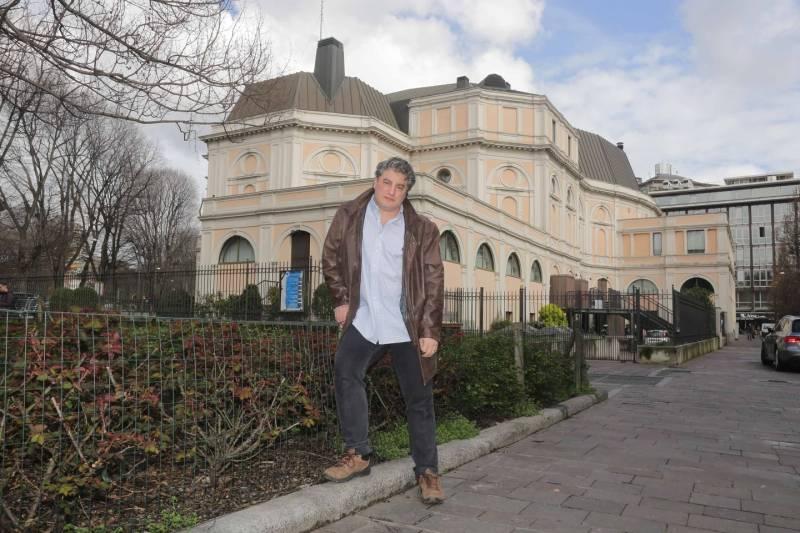
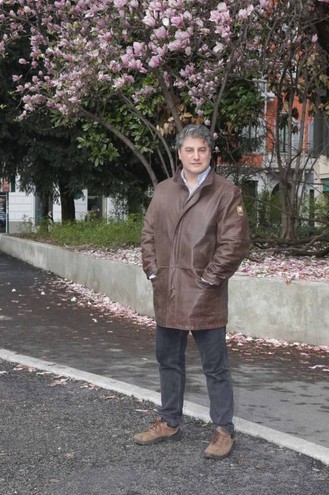
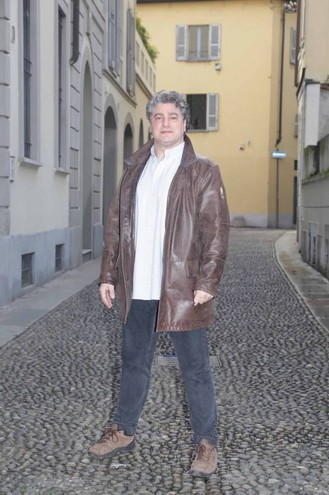
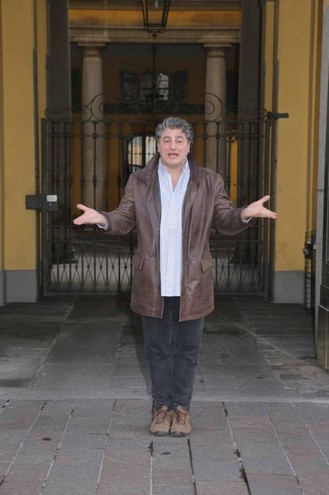
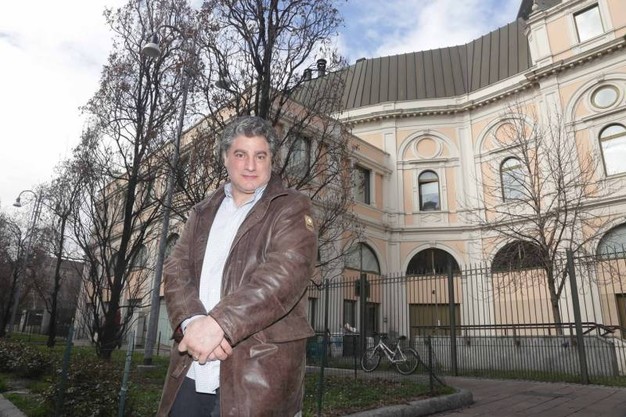
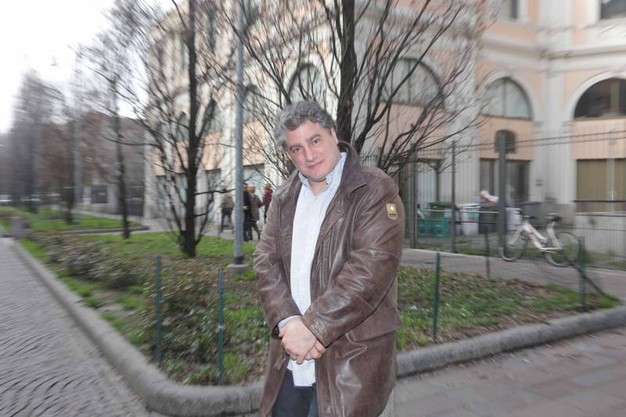
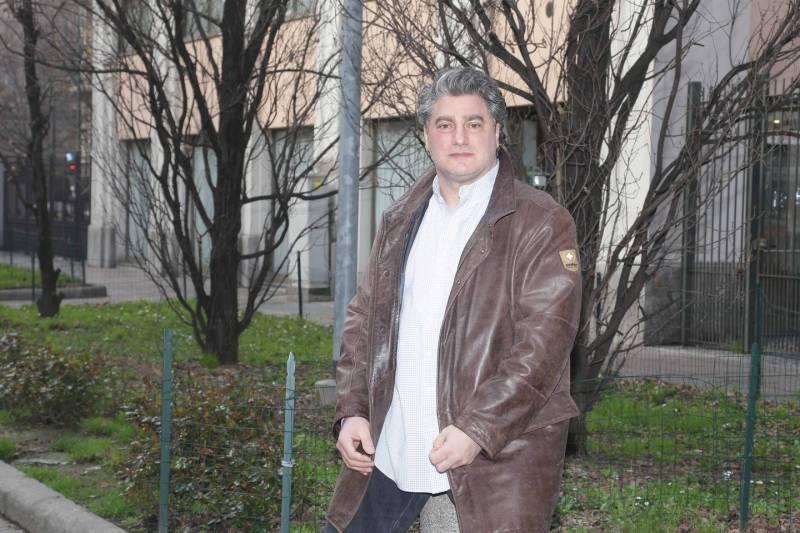
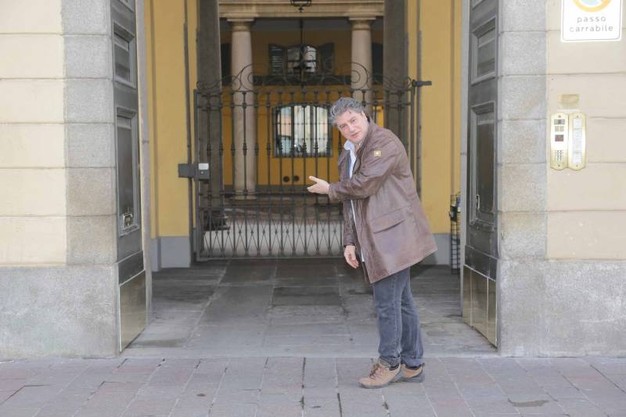
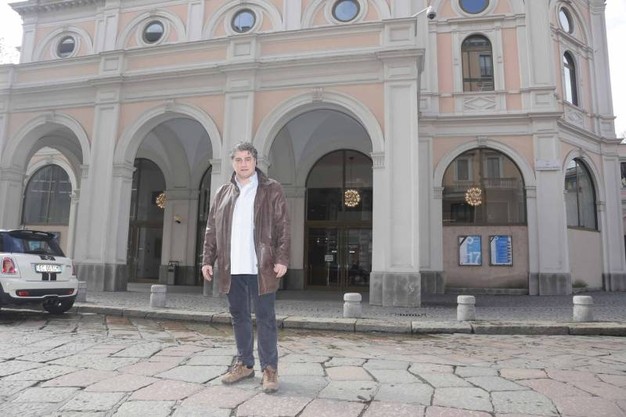
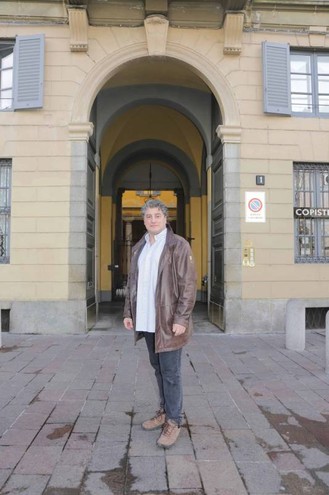
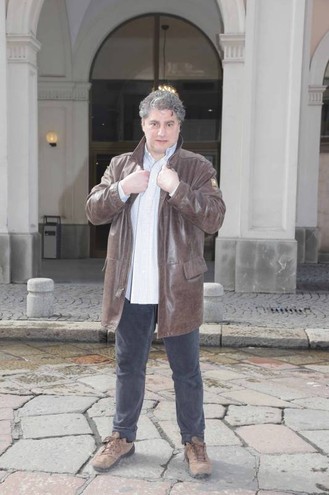
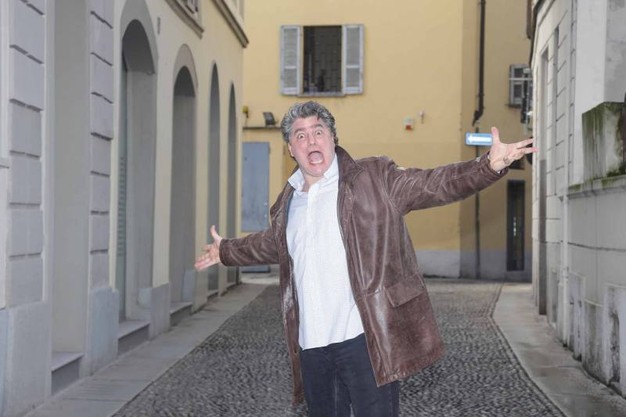
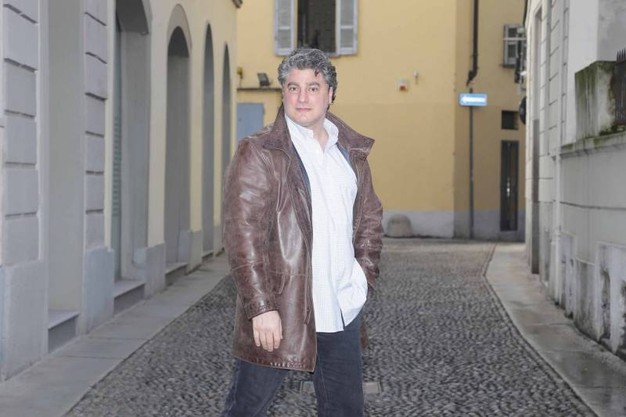

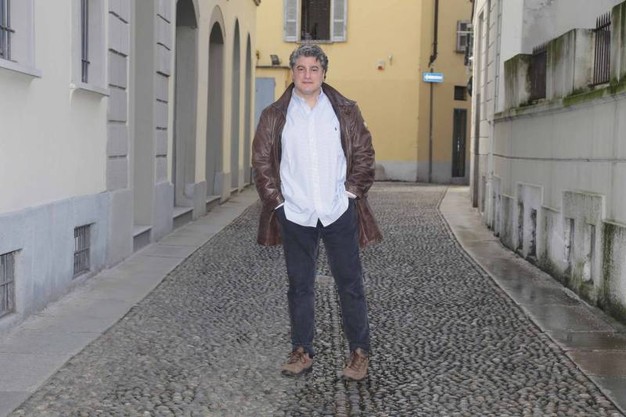
Bravo Cura
Celebrating José Cura--Singer, Conductor, Director
Carmen 2015 - 2020
Carmen 2015 - La Scala
|
|
José Cura: Milan for me is an epic city, the symbol of the hard struggle to assert oneself in life "Milan seems difficult at first approach, while it reveals its deep heart to you only if you commit to looking for it" Il Giorno Massimiliano Chiavarone 17 May 2015
[Computer-assisted Translation // Excerpts]
Walking around Milan with José Cura Milan, May 16, 2015 – “Milan is an epic city: the challenge, the struggle to assert oneself, while all around there is rain, traffic, material and organizational difficulties to deal with.” This is what tenor José Cura, one of the names that dominates the international opera scene but one also presented on theater calendars as a conductor and director, tells us. In short, you are a versatile musician who was able to use Milan to give impetus to your international career. Is that right? Yes, I arrived in Italy in 1991 for two reasons: to find my roots, because my grandmother was in Santo Stefano Belbo in the province of Cuneo, and to look for work. I started going around to opera agencies looking for auditions. Unfortunately, no one would even give me a chance so I decided to play one last card: I had with me the phone number of the teacher who had taught one of the artists from the Colón. It was the tenor Fernando Bandera. I called him and he offered me an appointment in Milan. When I arrived in this city it was April and it was pouring rain. And so began your story? Defying adversity starting with bad weather? Yes, even though in later years I have joked about it myself, it really was the beginning of the story. After hearing me, Maestro Bandera said: “Bravo, you have an important voice”. Then he asked me what my plans were and I him I had none because I had to go back to Argentina. And he replied: “You are not going anywhere!” So he got me my first agent, Alfredo Strada. Did you find work? Not right away, because Alfredo told me that my voice needed some fine-tuning, especially stylistic, and he also got me a vocal teacher, Vittorio Terranova, who gave me free lessons from 1991 until mid-1992. It was an incredible act of generosity that gave me the strength to keep going. When did you discover you could sing opera? At 20. I was studying orchestral conducting and composition in Argentina. Singing was a complementary subject. The rector of the university heard me sing and told me to cultivate my voice, primarily so I could also refine my conducting skills. I followed his advice and discovered that I could become a tenor. So many years later, what does Milan mean to you? It is the city where I became familiar with my profession, but also a place that remains partly unknown to me. Milan seems hostile at first approach but it will reveal its deep heart if you commit to looking for it. And you discover authentic beauties such as the San Maurizio complex, including the Civic Archaeological Museum a hundred meters from Via Camperio. Is that your favorite street? Yes, I happened upon that street for the first time in 2011. I needed a place to stay during the period in which I sang Pagliacci at La Scala and the search was successful: I found a hotel that assigned me a room that had never been rented before, because it had just been renovated. Since then, every time I return to Milan I stay in the same place and they give me the same room. Walking along Via Camperio I feel like I am returning to the Milan of the past, when it was a village crossed by small streets. It is a particular street where I feel comfortable, perhaps also because of its proximity to the Dal Verme theater where the first performance of Pagliacci took place in 1892 Sometimes the audience at La Scala has not always been kind to you. How do you explain it? I can't associate the entire audience with four rude people. Nor can I say that "they only have it in for me". These protesting people target those who have a personality and don't show deference for fear of being booed. At La Scala they have "got" many artists, including Callas. Boos are part of the history of the theater. They are now more than a manifestation of dissent, an expression that has to do with the folklore of Piermarini. When will you return to Milan to sing? "I have no idea. After more than two decades of career, I find pleasure in performing only in places where the audience shows respect. I've already done my apprenticeship! It's a shame, because La Scala, as an opera house that combines multiple excellences between orchestra, chorus and technical facilities, is truly remarkable."
|
|
|
|
|
Act I
|
|
Act II
|
|
|
|
|
|
Act III
|
|
Carmen, 2015, Milan: “Before the curtain went up on the second performance, Superintendent Pereira came out to announce that José Cura, recovering from the flu, would sing under less than perfect vocal conditions but would do his best on the occasion. No exhaustive judgment of his performance will be offered, with him limited in his vocal participation which allowed only a glimpse of the generosity of intent. The singer, while displaying credible and robust passion, on this night was not able to provide in-depth exploration of the character. [Still] an affectionate welcome.” Italia Post, 28 March 2015
|
|
Low voltage Carmen in Emma Dante's return to La Scala
Bachtrack 30 March 2015 This is the year of Milan's Expo - the international Summer exhibition on everyone's lips - for which La Scala have extended their season and pulled some old productions out of the wardrobe. Emma Dante's Carmen received a famously mixed reception at 2009's season-opening performance from press and public alike. Barenboim assured it would become "a legend production", whilst traditionalist opera director Franco Zeffirelli claimed that it had caused him to see the devil. This year's version remains largely intact, though the original star-studded cast has received an overhaul. There was often a lack of chemistry between tonight's leading roles this time around. Elīna Garanča's blonde Carmen possesses an innocent streak, and her cheery "Habanera" lacked the necessary sass to get our pulses racing. José Cura's Don José is world-weary and seemingly old enough to be Carmen's father - impassible and often immobile, he hardly flinched when Micaëla relayed news from his dying mother, sweetly conveyed by Elena Mosuc as this was. Such a low voltage rapport between the main characters made it difficult to buy into the plot's tragic developments or the various directorial quirks. In a reversal to conventional practice, Carmen rather than José plunged the dagger into her heart at the work's climax, which was a somewhat implausible feature when there had been so little in the way of a dramatic buildup. But in spite of these weaknesses, there were moments where the characters' relationships started to kindle. Carmen ensnared her captor José with a hazy "Tra la la", entangling him in the suspended ropes that bound her arms, and the tension bubbled in a candelabra littered Lillia Pastia's, with José tormented and Carmen burning with resentment at his refusal to desert the army. There is by now some wobble to Cura's voice, but he is capable of shifting cleanly through the gears to find an emotive range. Massimo Zanetti, a dapper silver fox of a conductor, overflowed with energy, and we might have wanted him to steal through the texture more often to provide some oomph. The prelude to Act III had utter poise, whilst that to Act IV brimmed with joie de vivre and all the zest of Seville oranges: smouldering strings, lippy brass and rapping tambourine. And there were also heart-warming contributions from gypsy swashbucklers Frasquita and Mercédès, charmingly conveyed by Hanna Hipp and Sofia Mchedlishvili respectively. There is impressive depth and sheen to Mchedlishvili's voice who, like her fast-rising compatriot Anita Rachvelishvili, is a product of the La Scala Academy. A much bigger problem in this production than casting or individual performances was posed by the direction and scenography. Dante shares with Zeffirelli his penchant for buzzing, bustling sets, which was easy on the eye in the case of Act I's heaving piazza with marching children, trinket flashing gypsies and a woman giving birth. But incongruities between the sets cause disorientation when we switch to a geometric blankness for Act III's mountains, or to Act II's Lillia Pastia's Inn in an underground lair, borrowed from a James Bond villain perhaps, where a slowly descending dumb waiter didn't allow Escamillo the most imposing entry. Without grounding in time, place or a coherent aesthetic, the narrative is left to flap helplessly in the wind. In particular, Dante has the tendency to clog the drama with cloying symbolism. Religious imagery abounds, for example with a hearse crossing the stage to spell out Carmen's imminent death from the off. When factory girls dressed as nuns disrobe to nightdresses before frolicking in a steam-filled fountain, we are unsure whether we are supposed to feel aroused or amused. Far from sharpening our focus, the symbolism tends towards the obscure, and it is often gratuitously nauseating, so that watching bloodied factory girls kicked into the air by raving soldiers made for an uncomfortable sitting. It was surely no coincidence that moments of dramatic clarity coincided with respite in the stream of allegory. |
|
Applause and boos: Emma Dante's Carmen divides La Scala RAI News 23 March 2015
[Computer-assisted translation // Excerpts] Applause and boos: this is how the audience at La Scala welcomed Georges Bizet's Carmen last night in the show directed by Emma Dante, the same one that opened the 2009-2010 La Scala season. This time on the podium it was not Daniel Barenboim, who at the time achieved personal success, but Massimo Zanetti who was welcomed to the proscenium with boos that almost drowned out any applause—and the boos were not only limited to the gallery. Some dissent was also directed at both male protagonists, the tenor, José Cura, and Vito Priante (Escamillo). Applause went to Elena Mosuc (Micaela) and Elina Garanca, a Carmen with a pale complexion, blonde and perhaps not very provocative in her gestures, but with an impeccable execution. Absolute applause for the La Scala choir, always up to its fame, led by maestro Bruno Casoni, as well as for the children's voices of the Accademia della Scala. The director did not appear on stage. In any case, the performance did not arouse open dissent as happened at the La Scala premiere six years ago. The production is substantially the same, without any particular changes.
|
|
Act IV
|
|
Boos fight applause for Emma Dante’s Carmen at La Scala Gazzetta del Sun 23 March 2015 Audiences boo conductor Zanetti [Computer-assisted Translation // Excerpts] One of the world's most frequently performed operas, Carmen, took the stage at Milan's La Scala opera house on Sunday night, closing its curtains to enthusiastic applause marred by rampant booing for the performance's conductor, Massimo Zanetti. This staging of Carmen, directed by Emma Dante, is a non-traditional production set in a small square in southern Italy, without particular references to the Spanish folklore of Seville, where French composer Georges Bizet's original 1875 Carmen is set. Emma Dante's Carmen is influenced heavily by the Catholic Church, evidenced by symbolism connected to the character of Michaela, which contrasts sharply with the secular representation of Carmen, who pays for her autonomy and independence with her own life. Sunday's debut elicited much the same reaction as it did when it inaugurated the opera house's 2009-2010 season, albeit that time under conductor Daniel Barenboim who received an unequivocally positive reception. The overall dissent wasn't as intense as that delivered by the audience at the December 2009 staging even though the production itself remains more or less as before. The audience was pleased with the technically perfect performance of Elina Garanca, the Latvian mezzo-soprano covering the title role, as well as Elena Mosuc as Micaela. A less-supportive reception was to be had for tenor Jose Cura [and] Vito Priante who performed as Escamillo.
|
|
A “new” old Carmen at La Scala Il Corriere Musicale Luca Chierici 3 May 2015
[Computer-assisted translation // Excerpts]
Third revival of Bizet's opera in the Milanese theater; the new cast is not entirely convincing, not even the much applauded protagonist. The review of successful productions can often turn into a testing ground that allows us to evaluate the extent to which the various components (singers, conductor, direction, sets, costumes) interact with each other. There are exceptional cases in which all these components take on a very high value in their singularity but also in the fusion between the different elements, and this leads to the creation destined to represent a real reference point in the history of a theater. In these cases the fundamental invariant is the one relating to the production, which when successful is rightly presented in subsequent seasons: of historical importance then are those productions that maintain their iron coherence even as the other components of the performance change, or that are illuminated differently when the company or the musical interpretation by changes made by the director. The Carmen that was staged last Sunday once again tipped the balance between the various components and in our opinion demonstrated how Dante's direction was intimately tied to certain particular choices made by the performers. Elina Garanča, a Carmen of anything but Mediterranean beauty and charm, offered a marvelous performance, yes, in terms of homogeneity of timbre and stylistic purity but seemed clumsy in her movements and often gave the impression of being lost among cigar girls, gypsies and smugglers: a blonde from the East who ended up there by chance. In contrast, José Cura presented an extremely traditional Don José but his still considerable vocal means did not quite rise to previous successes. Vito Priante's Escamillo, a baritone who has in the past decade embarked on a more than interesting career despite starting from premises musically far removed from this Bizet, appeared all too polite and elegant, so much so that it was he, certainly not the aggressive and expressive Cura, who was really the ideal partner for Garanča's impeccable Carmen from a purely vocal standpoint. [But the author feels this ‘prissiness’ by Garanča and Priante is what lessens the impact of this performance.] The most heartfelt applause went to Elena Mosuc’s very effective Micaela; she is gifted among other attributes with a soft and very expressive voice. The temperature in the theater was very high, not so much during the performance as at the end, when a notable brawl broke out between supporters and detractors of Cura. Massimo Zanetti received whistles of disapproval…
|
|
Carmen, Milan, March 2015: “[Garanca’s] sparring partner was an old acquaintance: José Cura. His bravura stage presence was [was matched] by vocalism that alternated between beautiful passages of great intensity to cries at the vocal limits. As Don José, because the character is all passion and no control, he is still credible. He reciprocated the predicable boos at the end of the performance with a greeting and a kiss.” Operaclick, 22 Mar 2015
|
|
|
|
Carmen 2019 - Muscat



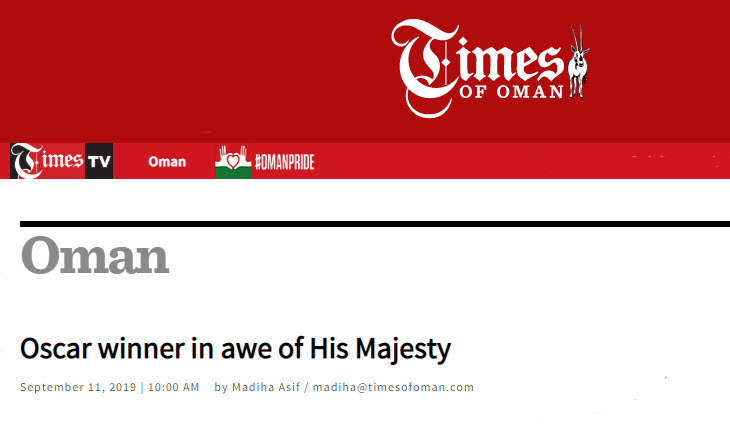
|
[Excerpt]
Muscat:
An Oscar winning art director has praised His Majesty Sultan Qaboos
bin Said for bringing the Royal Opera House to Muscat and connecting
everyone from across the world through it. Returning to Oman after a gap of eight years, Quaranta is the director, set and costume designer for one of the most frequently performed operas in the classical canon, Carmen, which came to the ROHM as a specially commissioned production for the landmark Inaugural Season in 2011. [...]
Speaking about how he feels about reconnecting with the lead performer
– José Cura, who will appear as Don José - Quaranta said that no one
better than him could have done it.
|
|
|

|
José Cura returns to the Royal Opera House of Muscat as Don José in Carmen
Ópera Actual Fernando Sans Rivière 01 September 2019
[Madrid-approved Translation]
©
Zoe CURA The Argentine tenor returns to Oman between 11 and 14 September 2019, after his great success last season with Pagliacci. This time he will sing his iconic Don José in Carmen, along with mezzo Elena Maximova [Carmen], George Petean as Escamillo, Anita Hartig in the role of Micaëla and musical direction by Antonello Allemandi in charge of the Orchestra and Choir of the Theater Colon of Buenos Aires. For the Argentine tenor José Cura, it is both a great satisfaction and responsibility to participate in this Carmen, which will be offered alongside the Orchestra and Choir of the Teatro Colón from Buenos Aires. Ópera Actual: What do you think of the character of Don José and what do you remember about your debut [in the role]? José Cura: My relationship with Carmen dates back to the eighties when, as a young composer, I made a complete arrangement of the work to be presented in an hour and a half and with a mixed group of Spanish and symphonic instruments. As a singer I debuted in the role of Don José in 1996 in San Francisco, having as a partner Olga Borodina who was also debuting in the role of Carmen. We were both very young. OA: How has your character of Don José matured over the years and what do you think is your personal contribution? JC: There is a basic confusion about Don José Lizarrabengoa, born of the beautiful but unrealistic French reading of a Spanish subject. In Carmen, the radically opposite psychologies of the introverted Basque and the carefree Andalusian face off in a clash of cultures that, even today, are the subject of television series and films such as Eight Basque surnames, for example. Despite this de facto fact, Carmen develops into an almost a caricature of the Andalusian personality of the female protagonist, confining José's interpretation to that of a silly half-dummy, of childish behavior, almost capricious. José is young, but the boy's freshness has long since ceased and has transformed into a shock-induced maturity. To understand, let's compare the adolescence of a middle-class Western boy with that of one born and raised in Syria under the sign of the bombs ... Don José killed two friends because of an argument over a game and then, to escape justice, he enrolled in the army where he was protected by the martial law of the time. Even as a soldier he is a time bomb. The first time a superior humiliates him, he explodes with unpredictable consequences. Someone with such psychosocial instability is then crossed by a sensual, elusive and fatal woman - fatal in the etymological sense of the word, linked to destiny - like Carmen, who is more amused with deflowering him than in truly loving him. Let’s not forget that in the repressive literature of the nineteenth century the word love did not necessarily represent feeling as such but was a euphemism of sex. It is a euphemism that, a little by modesty and so much by habit, we continue to use today in that we “make” love instead of "feeling it”... I try to reconcile respect for the French style, singing in a rather demure way the first two acts, gradually releasing the sullenness as the third act progresses, and then move from the pathos of one who begs to be loved to the wild hatred of one who has been rejected in humiliating ways. Humiliation: here is the keyword. José doesn't kill Carmen because she rejects him. This was fixed with the umpteenth discussion. José kills Carmen for the same reason that he killed those two guys at the beginning of his life journey, and for the same reason that, in the novel, he kills one of his officers and also Carmen's husband, one-eyed Garcia: because they humiliated him in public! This raw reading is, in my opinion and after more than 30 years of relationship with the work, the only way to make the best of two worlds that are musically and culturally opposed, as French and Spanish, in the light of a modern interpretation, without mannerism, of this magnificent work. OA: You have already sung Pagliacci in Oman. What do you think of the Theater and the country? JC: Muscat is a pleasant city, without skyscrapers, where the buildings are white to minimize the effect of the sun inside the houses. The contrast between the new, but traditional architecture, and the soft, sandy colors, against a perennially blue sky and a wonderful sea, gives a sense of great peace. That, if the heat is endured! On the other hand, Oman is a clear example of intercultural and interreligious tolerance. People, always with caution, can go around dressed as Europeans without fear and even wear crosses around their neck. There are even churches of other religions. And ROHM is a mirror of all this: an effective theater to the extreme, of a beautiful architecture in which one works with great artistic and logistical serenity. OA: What does it mean to travel to Oman with the Orchestra and Choir of your homeland? JC: When I was asked with which theater I’d like to return to Oman after the success of Pagliacci, I didn't hesitate for a second. I am myself acting as liaison and negotiator between the two administrations. With tenacity and professionalism an agreement has been drawn that will set an undisputed precedent for the exemplary nature of the great Argentine coliseum when it comes to serving as our country’s ambassador abroad. OA: Do you know Gianni Quaranta’s stage proposal? JC: I've seen photos and videos. It is a serious staging and respectful of the work, in which the artistic bodies of the Teatro Colón and the cast of international soloists, together with the Antonio Gades Ballet, will be very comfortable. OA: You will also conduct Beethoven’s Ninth Symphony in Oman with the Colón’s Orchestra and Choir. JC: Yes, it is the Beethoven work that I have conducted most. My return to the orchestra direction and composition are consolidating naturally in my career as, by the law of life, as a singer I reduce performances. I have finished my contract with the Prague Symphony and have just signed as the main guest artist of the Hungarian Radio. With them we will do, among other things, the recording of my Ecce Homo oratory, the world premiere in concert form of my opera Montezuma and the Red Priest and, in 2022, the world premiere of my Argentine Requiem for which I would love to have the Colón’s Choir. OA: What operas do you have programmed as a stage director? JC: In 2018 I directed and starred Peter Grimes in Bonn and Monte-Carlo, Nabucco in the Prague Opera and La fanciulla in the Tallinn. In 2019 I hope to finish my opera as mentioned above and I will return to stage direction in 2020 with a new production of Otello. |
|
|
|
Note: this is an excerpt.
Royal Opera House Muscat Review: Carmen
Buoyed by Vibrant Artists, Gianni Quaranta’s Production is Glorious To Behold
OperaWire David Salazar
(Photo credit: Khalid AlBusaidi / ROHM) This review is for performances on Sept. 11 and 14, 2019.
Writing a review after an initial performance of any run is a challenging proposition. You are essentially recording your views on a first impression without really getting a chance to see the full picture. There are many reasons why this is the case, but in taking on some productions, it is truly possible to get a more panoramic view of a production and its development to fully understand the artistic intentions. This was undeniably the case with the Royal Opera House Muscat’s production of Bizet’s “Carmen,” which opened on Sept. 11, 2019 and featured two subsequent performances over three nights. OperaWire saw the opening and closing night shows, which were completely different in how they told the story. The production, a revival of Gianni Quaranta’s vision, is a visual spectacle that rivals the imperious opera house itself and its own imposing elegance and vibrancy. Quaranta’s set design is Zeffirelli-esque in its incredible detail, immersive nature, and adherence to a traditional approach to the French opera.
Glorious Hyper-RealismAs audiences entered the hall, the stage represented the outside of a bullring with three archways in the center. During the overture, a few towns people, dressed in Spanish garb of the 1800s would walk to and fro. Immediately, this established the world of the story, but also emphasized the motif of the bullring as central to the story. It also teased the opera’s final scene in which José and Carmen’s fateful confrontation would take place in the exact place where the opera started. The bullring would then open up to reveal the distinct locations of the four acts, each opening frame an assault on the senses, in the best of ways. For Act one, we got to see the town square, with a glorious backdrop that rendered the town expanding into the distance. In Act two, Lillas Pastias’ Inn was rendered gloriously with chiaroscuro lighting. Perhaps the most incredible image to materialize when the bullring parted was the two level mountains of Act three with caves and alcoves embedded to create a sense of increased claustrophobia. Set against blue lighting, the coldness of this environment only furthered the increased distance between Carmen and José. Finally, Act four opened up to the inside of the bull ring itself with a massive chorus seated all over. The parade itself entered, with horses from the Omani Sultan’s own stable joining in, adding to the sense of spectacle and hyper-realism at hand; the varied color of the distinct wardrobes added to this overwhelming experience. The set then closed up again for the final confrontation, emphasizing the circular nature of the story. [...]
The Tragedy of Don José But the most questionable aspect of the production was the narrative shift to portraying the opera globally as the tragedy of Don José. As the overture shifts to the Andante moderato in A minor, a man limps on stage, seemingly running away from some oncoming attacker. As he nearly makes his way from stage left to right, his attacker reveals himself – Don José. The opera’s tragic hero suddenly runs across the stage, behind the columns and stabs the man. The overture comes to an end with that image, suddenly transforming the entire story and subverting audience expectations in a truly uncomfortable way. Per Quaranta’s program notes, José is wanted for this murder and thus enlists in the army to redeem himself and show himself to be a man of honor. As such, the opera’s formal narrative becomes, as Quaranta notes, “a drama about the impossibility of escaping one’s temperament.” We get closer looks at José’s monstrous behavior as he impulsively kills Zuñiga at the end of Act two and abuses Carmen right from the start of their reunion in Act two; his famed aria “La fleur que tu m’avais jetée” is not a declaration of love but an apology after having grabbed Carmen and thrown her violently to the floor. It only goes downhill from there. A dark vision of José is in and of itself not problematic, especially in the #metoo mileu. Tenor José Cura, who interpreted the character, noted in conversation that he sees José’s love for Carmen as nothing more than sexual awakening for a teenager and that his possession arises not from a sense of love, but machismo insecurity. Quaranta’s argument, also expressed in conversation, furthers this assessment of José as an exploration of a social attitude, noting that the character’s murderous tendencies needed to come from somewhere and as depicted in the opera, it is hard to believe that a man of virtue could stoop so low without antecedents of such behavior. Furthermore, by being forgiven for his crime, he was being supported by the social structure. Finally, he pointed to Merimée’s darker vision of the character in the original novella. And this is all well and fine, but it comes at a cost – Carmen. Any potential “love” between them does not exist in this production. The opera itself doesn’t present many chances for creating a credible sense of connection between the two and the choices here only furthered the audience from any such notion. Quaranta has explained that Omani regulations forbid that he have the characters engage in any suggestive behavior, with even kissing completely off limits. This undeniably hindered this aspect of the production, but with no other workaround, the result only emphasizes the emotional void between the two; the choice to make physical abuse the defining aspect of the relationship only exacerbates it. So one ends up asking why she even bothers with him in the first place? The story thus turns Carmen into someone that keeps coming back for more, even though she knows that she can’t control the guy and that he’s just going to keep doing the same thing again and again. One might argue that the entire final duet in this production happens because she goes looking for a rendez-vous with José and that’s why she leaves the stadium. Furthermore, her understanding of his abuse comes to a head when Carmen even toys with those limits and her understanding of them. When he points the dagger toward her, she laughs in his face, suggesting that she knows he won’t do it; he’s done the same thing in Act three and wouldn’t go further. He bullied her in Act two and then apologized. So when he does stab her, she’s surprised by his action. She wasn’t ready to die and now the system of control and violence has finally destroyed her. And yet, she doesn’t end up the tragic heroine of the piece. He does. Despite the depictions of her as a victim at the hands of a monstrous society, she is but a pawn in the hands of a greater fate that made the monster realize that he will always be subject to his unchanging nature no matter how hard he tries to get away from it. As at the beginning of the story, José was destined to kill again and it could have been anyone. And he might do it again in that very machista society. Carmen, in the larger narrative of Don José’s tragedy as depicted in this production, is as much a footnote in his life as the anonymous man he murdered at the opera’s beginning.
Violent Vocal Acting The opera’s main cast handled the challenges of this production rather well with Cura likely the standout on stage. During the habanera he maintained a sense of isolation, keeping his distance as best as he can. At one point, with her staring him down during the Habanera, he unsheathed his sword, a subtle suggestion to keep away from him. But when she threw the flower in his direction, something changed in him. He stood frozen in his place, his back to the audience. And yet you could sense the energy shifting around him. As people left the stage, his frozen position suggested some internal turmoil unspooling from the character. And this is where the performance across both nights diverged most readily. On opening night, Cura was distant and a bit removed from Micaëla during their duet. But on the closing evening, he was more open emotionally to her, even looking on affectionately and staring into her eyes, creating a beautiful connection at the close of the duet. As such, opening night would be defined by a more socially awkward and violent José with the closing performance hinting at his more tender side. With this particular opera, the tenor himself noted that he has more interest in exploring the emotional essence of José as a character, instead of falling into the trap of letting the deceptive nature of Bizet’s lush and romantic melodies take the lead. To that end, Cura’s voice is more an instrument for characterization instead of an instrument in and of itself. So we get harsher vocalization and phrasing, not always aesthetically pleasing [in] the traditional sense, that is furthered by the cruder colors of his Argentine tenor. So with such moments as the end of Act one, José’s line “Je suis un homme ivre,” which signaled a loss of his control and the next phase of his fall, was jagged and increasingly forceful, the high A sharp pushed with all its might. During the opening performance, Cura’s top notes had a frayed vibrato, but as the night went on, the squillo in the upper range was more controlled and poised. On the closing night, the squillo on the highs, despite some inconsistent intonation, was often solidly placed and resonant throughout the night. “La fleur” was affecting in unexpected ways. After having thrown Carmen down to the floor violently in an equally aggressive vocal display, the tenor walked away from her and sat on the table, his body closing up in shame. In this position, he sang the aria with very quiet and gentle tone, each phrase but a whisper. Opening night featured some unevenness of phrasing and inconsistent intonation with some of the lower notes coming off as accents next to the gentler middle line, but the effect was involving nonetheless; on closing night, the line was immaculate and beautifully constructed vocally. The aria, on both nights, became an apology and a character tending to a wound at the same time, with Cura increasingly ramping up the intensity throughout. The closing night performance featured a breathtaking crescendo on “un seul desire, un seule espoir” to the high A flat. The high B flat at the climax was delivered forte (and absolutely enthralling on the final show) with the ensuing “Carmen, je t’aime” sung with a glorious piannissimo diminuendo. Cura’s third and fourth act performance on opening night were his strongest by far, with closing night’s final Act perhaps even more intense in many ways. During the first performance, he unleashed the violence. There is nothing quite like the intensity emanating from Cura’s eyes as he grabbed Carmen and blasted out the passages “Tu me dis de la suivre” and “Je te tiens fille damnée” with increased passion. It was frightening to witness, the physical power furthered by the voice’s own dagger-like phrasing and forceful enunciation; it was quite surprising to see the third Act of the closing night lacking somewhat in this passion, which was one reason why, on that night, Act three was the least effective (it was the most impactful on opening night). While he had moments of gentle and tender singing in the fourth Act, Cura’s José snapped quite quickly and kept pushing himself further and further physically and vocally as the passage developed. His big “Pour la dernier foi” was the breaking point with the tenor leaning against the wall in frustration, before propping himself up, turning to Carmen and suddenly transforming into a monster in his physicality and glare. The high B flat on “Démon” was violent in its attack and the following text and musical line were crazed in delivery and execution. And despite Cura creating this sense of inevitability about José the entire night, he managed to express his tragedy in one very telling moment. Carmen stood right in his face, readying herself for him to kill her. He had his knife at the ready and then he stopped himself. He backed away, confused, and seemingly locked in internal battle with himself. It is when she laughed at him that he suddenly felt that he wouldn’t let her win. It was then, at the smallest of humiliations (albeit a public one), that the tragedy of José expressed itself and he murdered her. On closing night, the entire staging was changed with the two artists further apart on stage and Cura begging instead of imposing. It reflected more of a character desperate for love than a possessive macho.
Mesmerizing EnsemblesThe chorus of the Teatro Colón was truly mesmerizing the entire evening, particularly in the fourth Act where the combined voices were a tidal wave of effervescent sound. There was a lot of joy and excitement emanating from the chorus in this section. The orchestra was also having quite a fine evening, delivering one of the most energized and nuanced performances of “Carmen” that I have heard in a while. All the notes were the right place and under maestro Antonello Allemandi, everyone seemed to be taking the same breath both on and offstage. His only miscalculation was in the balance of the big ensembles. In solo passages and duets, he managed to keep the singers at the forefront. But in larger ensembles, the orchestra would always swallow up whatever sound came from behind. It is worth mentioning Christian Peregrino’s Zuñiga, Stacey Alleaume’s Frasquita, Laura Verrecchia’s Mercédès, Gustavo Feulien’s Dancaïre, and Sergio Spina’s Remendado for their involved portrayals. Peregrino was robust in his vocal interventions and matched Cura’s José during their intense duels. Alleaume’s high notes were pristine every time she unleashed them. Verrecchia, Spina, and Feulien were all solid in their respective ensembles. On the whole, this was an exciting series of performances that served as a sharp reminder of the ever-changing nature of theater and the freedom of exploration that a smart director can allow his thespians. This production was, on paper, as traditional as they come. And yet, the artists found ways to create unique interpretations of the same work and context on different nights.
|
|
Most photos by Sergio Sosa Battaglia
|

 |
|
|
|

|
Carmen (Bizet), Royal Opera House De Muscat, Teatro Colón de Buenos Aires
José Cura, Gianni Quaranta ... Memorable Version 15 September 2019 [Computer-assisted Translation // Excerpts]
Directed by Gianni Quaranta, Carmen inaugurated the 2019/2020 Season of the First Omani Coliseum and features some remarkable highlights, such as the brilliant conducting of the Milanese maestro Antonello Allemandi, realistic and rich decorations that transported the audience to the Plaza de Toros de La Maestranza (Spain) at the beginning of the 19th century. Also worth mentioning are some remarkable performances and perfect lighting. Russian mezzo-soprano Elena Maximova took the lead as Carmen. With long brown hair and a cheeky swagger, she definitely looked the part. During the first act and a half, her energy shone through and she portrayed a wonderfully playful yet seductive Carmen, a woman who knows exactly what she wants and how to make men adore her. Her voice, with an oddly defined center, gave a rich crescendo as she sang the famous Habanera aria (“Love is a wayward bird”) in which she warns men about her love: “If I love you, you better be careful!” It is not a voice with a wide range, but it is ductile in handling nuances. As the opera progressed (except in the last performance) Maximova seemed to lose the spirit of Carmen and weakened the character a bit. One can assume that she wanted to show a more vulnerable side, which diminished her performance. The role of Don José was played by José Cura. His beautiful, robust and brilliant voice gave a wide range of colors but it was his strength as an actor that was remarkable. His Don José was weak and unable to resist a captivating woman. He let his emotions get the best of him, and when he lost control, he lashed out. Cura [presented a character who] seemed tormented and frustrated, a perfect Don José! The most emotional moment of the performance was Cura’s passionate “La fleur que tu m’avais jetée” when he makes Carmen understand how much he loves her, “thinking/obsessing” about her during his two months of imprisonment through the aroma of the flower she threw at him. Both the audience and the writer felt the emotion on their skin.
|
Last Updated: Sunday, December 08, 2024 © Copyright: Kira